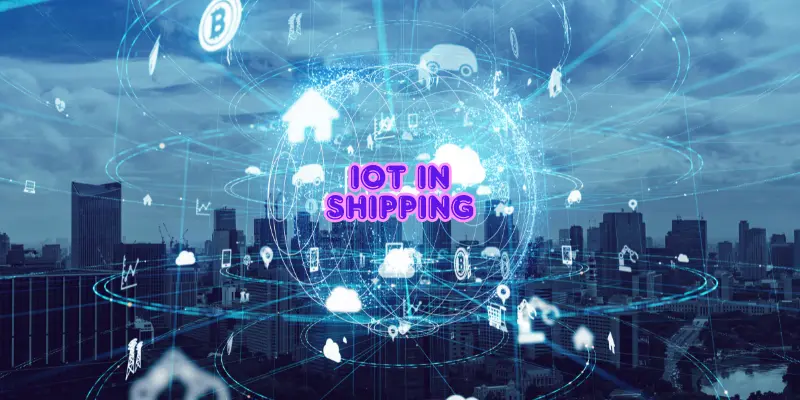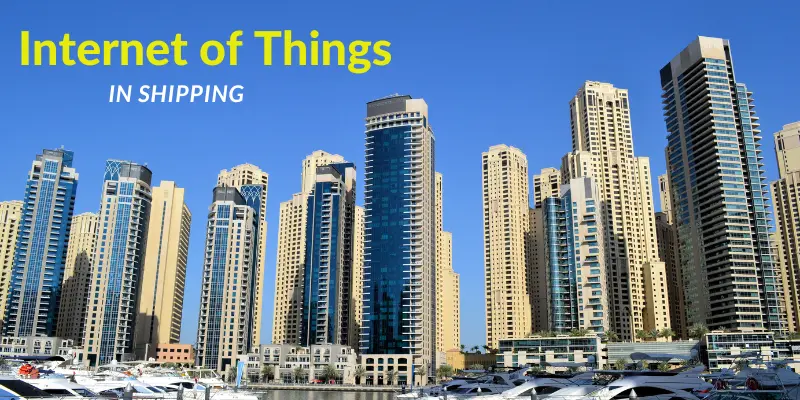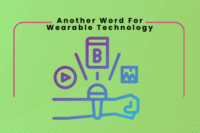Internet of Things in Shipping – A Path Forward for The Industry
Published: 09 Sep 2025
The Internet of Things in shipping is transforming the way goods are transported across the globe. Imagine a network of devices that communicate and share data to ensure shipments arrive on time, safely, and in the most efficient manner. This is what IoT is bringing to the shipping industry. The combination of advanced sensors, cloud technology, and real-time data analysis is solving some of the biggest challenges in shipping. From reducing delays to improving safety, the Internet of Things in shipping is becoming indispensable.
Why is this topic important? The shipping industry has long struggled with inefficiencies, such as tracking issues and high operational costs. By integrating IoT, companies can streamline their processes, reduce costs, and provide better service. Let’s dive deeper into how this technology is revolutionizing shipping and logistics.

The Role of IoT in Shipping
The Internet of Things (IoT) makes shipping smarter and faster. It helps track goods in real time, reduce delays, and improve safety.
Real-Time Tracking
One of the most impactful contributions of IoT is real-time tracking. Through GPS-enabled IoT devices, businesses can monitor the exact location of their shipments at any time. This provides transparency to customers and helps logistics teams address delays proactively. For example, a shipping company can use IoT sensors to track a container’s location and temperature. If a temperature-sensitive product is at risk, the system can alert operators immediately.
Inventory Management
IoT simplifies inventory management by automating stock updates. Sensors in warehouses and on shipping vessels ensure accurate records without human intervention. This prevents overstocking or running out of stock, which can disrupt supply chains. For instance, IoT devices in smart warehouses can notify logistics teams about low inventory levels in real-time.
Predictive Maintenance
Predictive maintenance is another game-changer in the shipping industry. IoT sensors monitor the condition of ships, vehicles, and equipment, identifying potential issues before they lead to costly breakdowns. For example, a ship equipped with IoT sensors can detect engine wear and notify engineers, allowing them to fix problems during scheduled maintenance instead of during operations. This reduces downtime and improves overall efficiency.
Benefits of IoT in the Shipping Industry
IoT helps the shipping industry work more efficiently. It cuts costs, improves safety, and makes deliveries faster and more reliable.
Improved Efficiency
The Internet of Things in Shipping significantly improves efficiency. IoT-enabled devices automate repetitive tasks, allowing teams to focus on strategic planning. For example, automating cargo tracking saves time and reduces human error. This streamlined approach leads to faster deliveries and better customer satisfaction.
Cost Savings
Integrating IoT can help companies save money in multiple ways. Automation reduces labor costs, while real-time data allows for optimized routes, saving fuel. For instance, IoT devices can suggest the fastest and most fuel-efficient shipping routes, cutting operational expenses.
Enhanced Safety
Safety is a top priority in the shipping industry, and IoT provides significant improvements in this area. Sensors can detect potential hazards like equipment failure or dangerous weather conditions, enabling operators to take timely action. For example, IoT sensors on a ship’s hull can monitor structural integrity, ensuring safety for both crew and cargo.
Challenges in Implementing IoT in Shipping
Using IoT in shipping is not always easy. High costs, data security risks, and technical issues can slow down its adoption. Similar challenges also appear in other industries. Our article on Internet of Things in the Travel Industry explains how IoT faces cost and security issues in tourism as well.”
Initial Costs
While IoT offers immense benefits, the initial investment can be high. Installing sensors, upgrading infrastructure, and training staff require substantial resources. However, many companies view this as a long-term investment, as IoT eventually pays for itself through cost savings and improved efficiency.
Data Security
With the rise of IoT comes the challenge of securing massive amounts of data. The shipping industry must safeguard sensitive information, such as cargo details and client data, from cyberattacks. To mitigate this, companies are investing in robust cybersecurity measures.
Skill Gaps
Adopting IoT requires skilled professionals to manage and maintain the technology. The shipping industry faces a shortage of workers with expertise in IoT systems. Providing training programs and hiring skilled personnel can bridge this gap.

Real-World Examples
Many shipping companies already use IoT. For example, Maersk tracks containers in real time, and UPS uses IoT to reduce fuel use.
Company Spotlights
Major players in the Internet of Things Shipping Industry are already leveraging IoT for better logistics. For instance, Maersk uses IoT technology to track its refrigerated containers. The sensors provide real-time updates on temperature and humidity, ensuring the safe transport of perishable goods.
Success Stories
Another great example is UPS, which has integrated IoT into its operations. With smart tracking devices and route optimization software, the company has reduced fuel consumption and improved delivery times. These success stories highlight the transformative potential of IoT in shipping and logistics.
IoT Trends in Shipping
New trends in shipping focus on smart tracking, automation, and greener solutions. IoT is making ships more efficient and eco-friendly. According to IBM IoT in Transportation, smart devices and sensors are shaping the future of logistics, helping companies cut costs and improve safety.”
Sustainability with IoT
Sustainability is becoming a critical focus for the Internet of Things in Logistics. IoT devices help monitor fuel consumption and reduce emissions, contributing to greener operations. For instance, sensors can track a ship’s fuel efficiency and suggest adjustments to minimize environmental impact.
Future Innovations
The future of IoT in transportation looks promising. Autonomous ships, powered by IoT and artificial intelligence, are already in development. These vessels can operate with minimal human intervention, reducing costs and human error. Another emerging trend is the use of blockchain with IoT to enhance transparency and security in shipping.
Internet of Things in Shipping Examples
IoT technology is already creating remarkable changes in shipping operations. Some real-world applications include:
- Smart Containers: Containers equipped with IoT sensors monitor temperature, humidity, and location, ensuring sensitive goods like pharmaceuticals and food are transported safely.
- Fleet Management Systems: IoT solutions optimize fleet operations by tracking fuel consumption, route efficiency, and vehicle maintenance needs.
- Remote Monitoring: Shipping companies use IoT-enabled devices to monitor port operations, detect delays, and streamline loading and unloading processes.
These examples highlight how the Internet of Things in Shipping is driving innovation and improving operational performance.
Internet of Things in Maritime Industry
The maritime industry is one of the largest beneficiaries of IoT technology. From cargo ships to port operations, IoT is revolutionizing how the maritime sector operates.
- Smart Ports: Ports are adopting IoT to enhance efficiency. Sensors monitor port activities such as crane operations, berth availability, and cargo movements. This reduces congestion and speeds up operations.
- Autonomous Ships: The maritime industry is experimenting with IoT-enabled autonomous vessels. These ships use IoT sensors and AI to navigate routes with minimal human input, reducing costs and improving safety.
- Environmental Monitoring: IoT devices in the maritime industry help monitor oceanic conditions, such as water quality and weather patterns, ensuring sustainable practices.
The integration of the Internet of Things in the maritime industry is unlocking new opportunities and reshaping traditional practices.
FAQs:
IoT in shipping refers to the use of interconnected devices and sensors to monitor and manage shipping operations efficiently.
By enabling real-time tracking, optimizing routes, and automating inventory management, IoT improves efficiency and reduces costs.
While the initial investment can be high, the long-term savings and efficiency gains make it worthwhile for most companies.
Conclusion:
The Internet of Things in shipping is not just a trend; it’s a necessity for modern logistics. By enabling real-time tracking, predictive maintenance, and automated inventory management, IoT is solving long-standing challenges in the industry. Despite the hurdles, such as initial costs and data security, the benefits far outweigh the drawbacks. As technology evolves, the Internet of Things in Transportation will continue to shape the future of global shipping.
If you’re in the shipping business, now is the time to explore IoT solutions. Start small, perhaps with smart tracking devices, and gradually expand as you see the benefits. The future of shipping is here, and it’s powered by the Internet of Things in Shipping.

- Be Respectful
- Stay Relevant
- Stay Positive
- True Feedback
- Encourage Discussion
- Avoid Spamming
- No Fake News
- Don't Copy-Paste
- No Personal Attacks

- Be Respectful
- Stay Relevant
- Stay Positive
- True Feedback
- Encourage Discussion
- Avoid Spamming
- No Fake News
- Don't Copy-Paste
- No Personal Attacks



